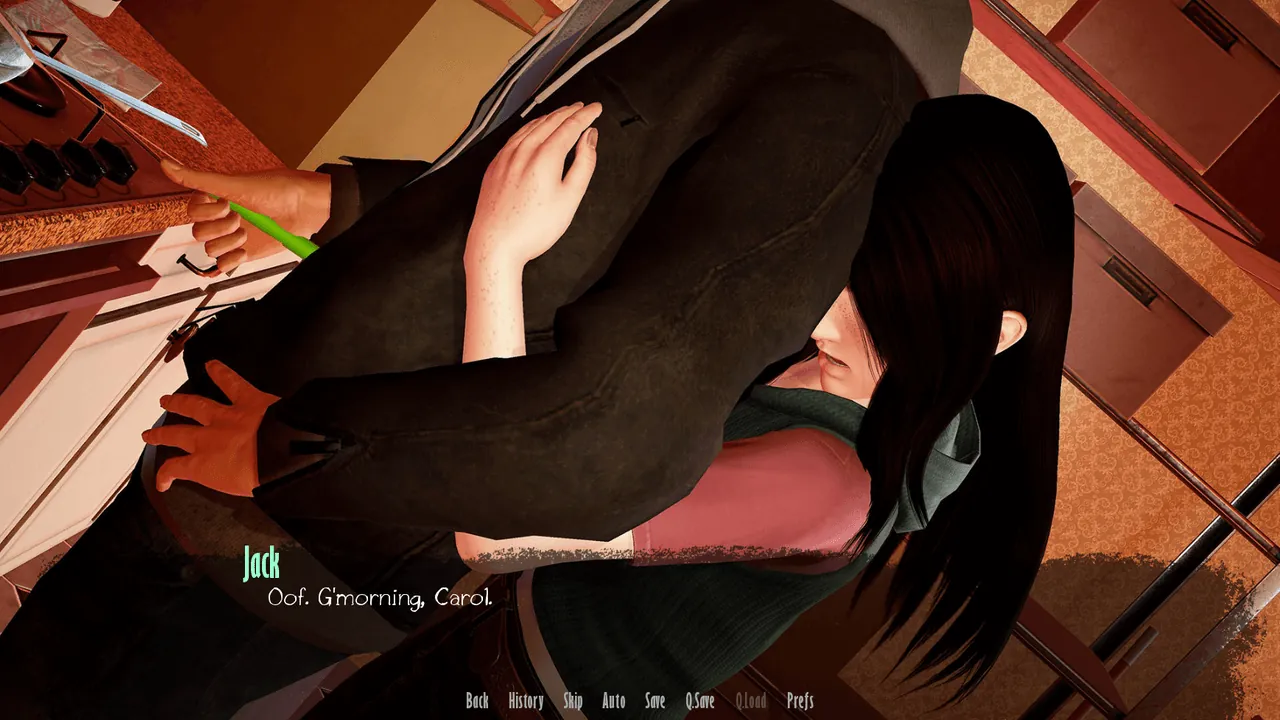
False Hero
Play False Hero
False Hero review
Explore corruption mechanics, character paths, and decision-making in this adult narrative experience
False Hero stands out as a corruption-based narrative game that puts player choice at the center of the experience. Unlike linear storytelling, this title allows you to shape your journey through meaningful decisions that affect character relationships and story outcomes. Whether you’re interested in understanding the game’s core mechanics, exploring different character paths, or learning what makes the corruption system unique, this guide covers everything you need to know about False Hero. The game emphasizes player agency, offering multiple routes and endings based on the choices you make throughout your playthrough.
Understanding False Hero’s Core Mechanics and Gameplay System
Ever found yourself playing a narrative game where your choices feel… inconsequential? 🎮 Where you pick dialogue options like you’re ordering from a menu, and the story just politely nods and continues on its pre-set path? 🙄 I know I have, and it’s why my first playthrough of False Hero was such a revelation. This isn’t your typical visual novel; it’s a complex web of cause and effect where every whisper and every glance can fundamentally reshape your world. The False Hero gameplay mechanics are built on a foundation of meaningful False Hero character choices, creating a truly dynamic decision-based narrative game.
At its heart, how does False Hero work? It trusts you with the power to truly change things. The game doesn’t just have a good path and a bad path. It has a labyrinth of branching story paths, each paved by your actions. The core of this experience, the element that sets it apart, is the brilliant False Hero corruption system. It’s the engine under the hood, and understanding it is key to unlocking the game’s deepest, most compelling narratives. Let’s pull back the curtain. 👇
How the Corruption-Based System Works
Forget everything you think you know about morality meters. 🚫 The False Hero corruption system is not a simple slider from “Saint” to “Sinner.” I learned this the hard way. In my first attempt, I thought I could game the system—be a perfect hero for the first half, then embrace my dark side later. The game laughed in my face. 😅
This system is more like a psychological profile that the game builds on you, tracking the nature of your compromises, not just the quantity. It’s a multi-faceted measurement of your character’s descent, and it operates in three key dimensions:
- Pragmatism vs. Idealism: Do you take the efficient, often ruthless, shortcut to solve a problem, or do you stick to your principles, even if it means a harder, riskier road?
- Self-Interest vs. Altruism: Are you accumulating power, wealth, and influence for yourself, or are you genuinely working for the betterment of others?
- Deception vs. Honesty: Do you manipulate and lie to control situations and people, or do you build trust through transparency, even when it’s difficult?
These aren’t abstract concepts; they are constantly being tested. A single decision might increase your Pragmatism while slightly decreasing your Honesty. The game’s genius is that these scores are often in tension. Helping one faction might require betraying another, boosting your Self-Interest while cratering your Altruism.
Pro Tip: Don’t try to “balance” your corruption. Lean into your choices! The most fascinating branching story paths in False Hero are unlocked by committing to a specific type of corruption, not by hovering in the middle.
The False Hero corruption system is also brilliantly opaque. You won’t see a numerical value on your screen. Instead, you feel it. Characters will comment on your changing demeanor. 🎭 The narrative’s color palette might subtly shift. Options that were once unavailable will start to appear in dialogue, reflecting your character’s changing mindset. It’s an organic, integrated system that makes your journey feel uniquely yours. This foundational system directly fuels the game’s complex character relationship paths, which we’ll explore next.
Character Relationship Mechanics and Path Variations
This is where the False Hero corruption system truly sings. 🎵 Your corruption level isn’t a universal key; it’s a filter that changes which character relationship paths are even visible to you. In most games, you befriend or romance a character. In False Hero, you can forge a partnership, create a toxic dependency, become a revered mentor, or even a feared manipulator—all with the same person.
Let me give you a personal example. I pursued a character named Elara on two different saves. In my “Idealistic” playthrough, where I prioritized Honesty and Altruism, we developed a slow-burn, trusting partnership built on mutual respect. It was sweet and fulfilling. ❤️
In my “Pragmatic & Deceptive” run, things were… different. I used lies and calculated moves to “save” her from a predicament, making her dependent on my cunning. Our relationship became intense, possessive, and fraught with tension—a far cry from the first version. It was a completely different character relationship paths, with unique scenes, dialogue, and a wholly distinct ending for her arc. This is the magic of False Hero character choices; they don’t just change an outcome, they change the entire nature of a connection.
The game tracks your standing with each character independently, but this standing is deeply influenced by your overall corruption profile. A character who values loyalty above all might become cold and distant if your Deception score gets too high, while a more ambitious character might only open up to you if your Self-Interest is sufficiently developed.
To see how this plays out, let’s look at how different corruption alignments can alter your potential relationships with key characters:
| Character | Low Corruption (Idealistic/Honest) | Moderate Corruption (Pragmatic/Self-Interested) | High Corruption (Deceptive/Manipulative) |
|---|---|---|---|
| Kaelen (The Idealist Knight) | Earns deep respect and a loyal friendship. Unlocks supportive scenes and allies. | Creates a tense, professional alliance. He questions your methods but tolerates them. | Leads to direct hostility and eventual confrontation. He may become an antagonist. |
| Seraphina (The Ambitious Merchant) | Views you as a naive tool. Relationship remains purely transactional. | Sees you as a valuable and like-minded partner. Unlocks lucrative business opportunities. | Develops a dangerous, obsessive rivalry. Can lead to a hostile takeover or a twisted partnership. |
| Lysander (The Jaded Spy) | Finds you amusingly innocent. Shares little useful information. | Respects your practicality. Becomes a reliable source of secrets and black market goods. | Views you as a kindred spirit. Opens up dark, exclusive quests involving assassination and espionage. |
Navigating these character relationship paths is the core of the False Hero gameplay mechanics. You’re not just picking who to be with; you’re deciding who you are in relation to them. And every step on these paths is determined by the decisions you make from the very first minute.
Decision-Making and Consequence Systems
If the corruption system is the engine, and relationships are the destination, then the False Hero character choices are the road you travel. 🛣️ This game has what I call a “cascading consequence” design. Small, seemingly insignificant decisions made in Act 1 can dramatically alter the landscape of Act 3. There is no “safe” option.
The game employs a sophisticated tracking system that remembers everything. It’s not just about the big, dramatic “Save the Village or Burn It Down” moments. It remembers who you slighted in a minor argument, which small favor you agreed to, and even which piece of gossip you chose to believe. This meticulous tracking is what makes it a premier decision-based narrative game.
Let me walk you through a real scenario from my playthrough to show you how this works in practice. This is a perfect example of how does False Hero work its narrative magic.
Example: The Cascading Consequence Chain
Early Game Decision (Act 1):
You encounter two farmers arguing over a stolen heirloom. You have minutes to decide.
– Choice A (Pragmatic): Quickly accuse the shifty-looking farmer based on circumstantial evidence. (✅ Increases Pragmatism, ✅ Saves time for a “more important” quest).
– Choice B (Idealistic): Insist on a thorough investigation, which takes much longer but uncovers the truth—the heirloom was accidentally taken by a child. (✅ Increases Idealism, ❌ Makes you late for another event).I took the “Pragmatic” route in one playthrough. I accused the shifty farmer, got the heirloom back, and moved on. Simple, right? Wrong.
Mid-Game Consequence (Act 2):
Weeks later, I needed information from a tight-knit community. The leader of that community was the brother of the wrongly accused farmer. He remembered my rash judgment and refused to help, forcing me to find a much more dangerous and expensive alternative. My False Hero gameplay mechanics session that night involved a stealth mission I was unprepared for, all because of that one “small” choice.Late-Game Consequence (Act 3):
The dangerous alternative I was forced into involved making a deal with a crime lord. This alliance later became a major plot point, closing off a potential alliance with the city guard (who were investigating that same crime lord) and fundamentally altering the endgame. The “quick and easy” choice in Act 1 had, over dozens of hours, locked me into a specific branching story path defined by criminal alliances and a distrustful populace.
This is the power of the False Hero corruption system and its integrated design. The game doesn’t tell you “this is a major decision”; it trusts the systems to make every decision potentially major. This creates immense replay value. 🕹️ My “Idealistic” playthrough, where I investigated properly, led to me having a strong ally in that community leader, which opened up entirely different quests and made the final confrontation against the main antagonist a very different, more straightforward battle.
Your False Hero character choices are the seeds from which your entire story grows. There are no take-backs, no do-overs. The game autosaves aggressively, committing you to your path. This might sound intimidating, but it’s what makes the experience so uniquely gripping. You are living with your decisions, and that emotional weight is something very few games manage to achieve.
Ultimately, understanding the False Hero gameplay mechanics is about embracing this philosophy. Don’t play to “win.” Play to see what kind of person your character becomes. Experiment with different corruption alignments and watch in awe as the game weaves entirely new character relationship paths and branching story paths for you. It’s a masterclass in interactive storytelling, and it all hinges on you having the courage to make a choice and live with the beautiful, messy, and utterly captivating consequences. ✨
False Hero delivers a unique experience through its corruption-based mechanics that prioritize player agency and meaningful choices. The game’s strength lies in how it weaves character relationships with consequence-driven storytelling, allowing each playthrough to feel distinctly different based on your decisions. Whether you’re drawn to exploring multiple character paths, experiencing different relationship dynamics, or uncovering how your choices reshape the narrative, False Hero offers substantial replay value. The branching system ensures that no two playthroughs are identical, making it a compelling choice for players who value choice-driven narratives and character-focused storytelling. If you enjoy games where your decisions genuinely matter and shape your relationships with characters, False Hero presents an engaging framework worth exploring.






























